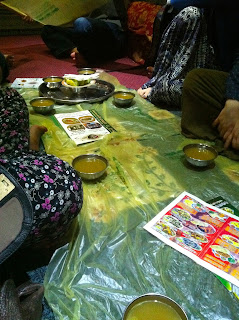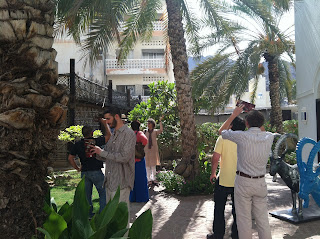I still have work to do, the quarter isn't over, but being here in Muscat, I feel like I am breathing again - for the first time since I started my program in September. I love living in new places, working to understand the cities, the streets, what places are considered important, how to stand in line (or not) at the coffee shop, what to order for breakfast.
I wasn't at all prepared for how beautiful this place is. Muscat is on the Indian Ocean, and the city has mountains that basically run along the coastline. Muscat began in a small valley, and has since expanded - geography permitting - in a long skinny line between the mountains and the ocean. The city is now approximately 50 km long, a series of valley enclaves connecting by a winding road along the sea. I love the mountains, and I love the sea - I am happiest when I am near both, which is part of why I fell for Los Angeles so hard...I can see how Muscat will easily and quickly become one of my favorite cities.

On Friday night, Judi, the program director, gave us a "starter kit" for our kitchens in our flats. Ours consisted of bread, sugar, creamer, and eggs...but on Saturday, we woke up and realized we had no coffee or tea in which to put the creamer and sugar, no oil with which to cook the eggs (or salt!), or a toaster or butter to sexy up the bread. Rather than choke down more food without flavor, after two days of airplane food, we went to try out a place across the street called Tea Corner. I got a Nescafe - instant coffee is the thing here, or else Turkish coffee (which is too strong even for me), and a raqaq b'il-labneh. It turned out to be basically a crepe, with labneh on it; the labneh I expected, and was part of why I ordered it. I had no clue what raqaq bread was, so I thought I'd give it a shot, figuring that at $1, I could always order something else if it turned out to be inedible. It was delicious. Then all of us packed into the bus with our driver Ma'foud, who drives better - and slower - when Judi is in the bus with us. When it's just the students, he takes the curves a bit quicker and is more aggressive with the merges.
Our orientation included some information about Oman that I mostly knew already, from reading Mandana Limbert's In the Time of Oil.
It is interesting to be around non-anthros, for the first time in a
while. The story of Oman's past 40 years is very different as presented
by Limbert than was presented to our group. Sultan Qaboos came into
power in the early 70s, and pushed for rapid modernization with oil
wealth. So roads were built; water systems constructed on a Western
style grid, instead of using wells and qanat, local irrigation systems;
the country got on the electricity grid too. The Sultan opened colleges
for women, and pushed mandatory education for women. This process was
described as bringing Oman from "the medieval to the modern" in a mere
40 years.
As an anthropologist, of course, I must ask: what is
modernization? What
does that mean? In which contexts? What gets lost or erased with these
changes, and how are they inhabited in people's everyday lives? If modernization is framed universally as positive progress, how does this frame the ways Omanis understand themselves, and how the West becomes situated as the paragon of progress/development? I have become habituated to being around brilliant people who think about these processes, and the ways that they can perform violence on communities, and I am profoundly thankful for them.
 |
| View on the way to the old city |
It took us about 40 minutes to drive into the city of Muscat - I hadn't realized how far west our center was. The roadways are lined with are date palms and mango trees, heavy with ripe fruit. It is beautiful and green and lovely here, despite the heat and humidity.
We
started by visiting the Sultan's palace, Qasr Al-A'lim - it's in the oldest part of
the city, and expansive and beautiful. The back overlooks the Indian Ocean, which is
so incredibly blue. Judi told us that when the Omani flag is flying over the main palace (see below), it means the Sultan is in residence, so maybe Qaboos saw us straggly sweaty group of Westerners on his lawn - the only people crazy enough to walk around in the mid-day heat.
The Sultan's residence! It looks like 70s architecture because it is...
This curved sword is called a khanjar - more on this later.
This it the view from the Sultan's backyard - not a bad gig if you can get it! It was 100 degrees and humid, and of course us girls
were covered head to toe - I wanted nothing more than to jump in that
water and cool off.
Note: the fort in the upper right here, and in the first picture in this post, are Portuguese-constructed. It is worth remembering that Oman, as controller of the Strait of Hormuz, has a lengthy history of trading with other countries on the Indian Ocean and as such, has historically dealt with both Persian invaders and Portuguese colonial mariners.
We then headed to the Bait
Al-Zubair museum, which houses a lot of artifacts and traditional
clothing and objects. The museum is divided into sections, so the
visitor can look at the khanjars (the curved swords, on the Sultan's
shield), women's clothing from As-Sharqiyah and Muscat, jewelry, men's
clothing and head coverings (kummahs are the "informal" caps), versus
the turbans (formal). The way a man's turban is tied denotes his tribal
affiliation, as does the style of his dishdash (the long men's dress),
so Omanis can read where someone is from by what he is wearing. Omanis
also read location and social placement by their last names - women
don't change their names when they get married, as family lineage is
more important than your married name.
This is a replica of a traditional Omani fishing boat.
A bunch of white people take pictures in the garden.
Myself included. It's hard not to fall for this place! The whitewashed buildings with their distinctive flat roofs, and the notched towers, stand out so magnificently against the trees, flowers, ocean and sky.
From there, we drove back along the water to the Muttra neighborhood.
The road from Al Qasr Al-A'lim, the Sultan's palace, back to Muttra winds along the coast, flanked by mountains to your left and the Indian Ocean to your left.
The Muttrah
souq is beautiful, especially the old part, where the wooden ceilings
are painted, like below.This souq wasn't nearly as big as those in Aleppo, Cairo, or Istanbul - at least, not the historic part. The newer tentacles of the Muttrah souq have spread out across the neighborhood in recent years.
There was lots of jewelry to tempt our jet-lagged tired eyes!
The shopkeeper joked about the nesting dolls, "It's an Arab
family: father, mother, daughter, son & camel." Sure enough, the
smallest nesting doll was a camel!
Oman is also well known for producing frankincense, which you may remember from Sunday School as one of the gifts the three wise men brought to celebrate Jesus' birth, along with myrrh (no idea where myrrh is from...). There was a lot of frankincense for sale, as well as other perfumes & scents.
On the road back to Seeb, the suburb where our Center and flats are, the heat and the jet lag put everyone to sleep...
Last night (after our nap), my flatmates and I went out in the Souq Al-Khoud neighborhood, where we live, to get dinner and buy some groceries.
We most definitely gorged ourselves at the Turkish restaurant across the
street, where we were brought enough hummus, pita, salad and kebabs to
last us three days. I also got my beloved limon bi-na'na, which is fresh
lemonade with mint in it. It's incredibly refreshing, and was my
favorite treat in Syria.
We have of course made
some mistakes, like at the grocery store when we just put the produce in
the cart. When we got to the checkout, we discovered that we were meant
to weigh it on the machine - in the produce section - and put the
sticker with the price and weight on it for the checkout guy to scan. So
we had to run back and sticker all our "capsicum" (peppers) and plums. But the Omanis I have interacted with so far have been very generous with my attempts to communicate with them, and laughed gently with us at our little gaffes. In all, it seems a very safe place to learn, because mistakes are not fatal and the environment is supportive.
Sunday morning, I woke up at 5am with the call to prayer - another thing I have missed and that I loved during my time in Syria. Perhaps it's my childhood experience, but I am so happy living in places that have vastly different traditions than my own - places that force me to learn things, to make mistakes, to take leaps to try to understand the people I share this world with. There is something so profoundly rewarding in making connections with others, who had different childhoods and speak languages I don't understand (or do so poorly). It is these experiences that give me hope for the future of our world.
 |
| A room of her own - the view from my room in Muscat |





































